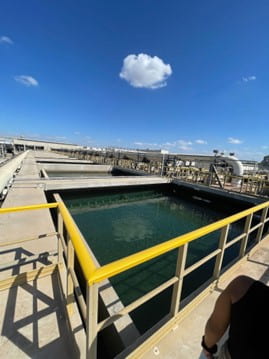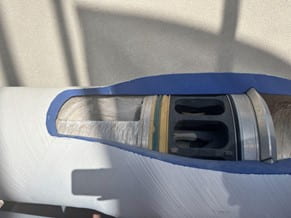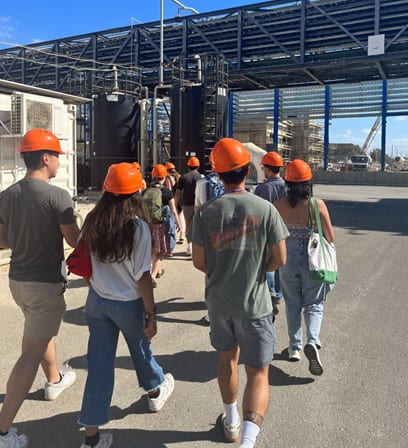By Iphigenie Bera, Destiny Lara, Damien Koh Tze-In
Introduction:
On September 16th, 2022, the Israel GET group visited the Sorek Desalination Plant, the biggest desalination facility in Israel. This trip aimed to gain further insight into Israel‘s water problem and learn about the desalination process in detail.
To open the discussion on Israel’s water situation, the speaker from Sorek highlighted the entire world’s water situation; he showed that only 0.62% of all water on the Earth is readily available to humans and animals. Additionally, by showing the individual factors contributing to the net water change in Israel, he stated that the country faces a shortage of 700 million cubic meters of water every year. Hence, justifying the need for desalination plants like Sorek.
Currently, there are five desalination plants already operational around Israel. They all provide a total of 597 million cubic meters of potable water every year. Once fully functional, two more desalination plants are expected to bump that number to 897 million cubic meters. With several factors, such as population growth and increasing standard of living, Israel will only require more desalination to sustain its home, industrial, and agricultural usage of water. Desalinated water makes up 75% of water for domestic use. The goal is to have 100% water supply for domestic usage from desalination.
Process:
The desalination process goes through several steps to provide drinkable water to residents of Israel. Sorek uses reverse osmosis due to its low power consumption and efficiency in desalination. The desalination process at Sorek can be divided into four processes, from intake from the sea to post-treatment for consumption. Processes are pre-treatment, micronic-filtering, reverse osmosis, and post-treatment.
First, Sorek carries water 1.85km from the Mediterranean Sea to their facility through an intake pipe. The intake pipe has a series of nets to prevent sea animals from flowing in the pipes, although some creatures, like jellyfish and barnacles, are sucked in. There are also brine output pipes that return brine back to the sea.
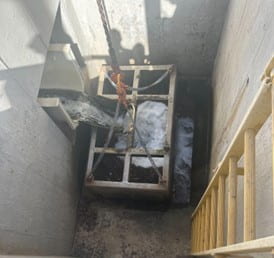
The intake pipe transferring water to the facility. At the bottom you can see jellyfish and barnacles that were accidently sucked in.
The water is then passed for further micronic-filtering by percolation in coal and gravel layers to remove smaller particles such as microplastics and sand. The sediments, after filtration, are removed from the top of the coal and gravel layer by pressure. The water then goes into the primary desalination process, reverse osmosis.
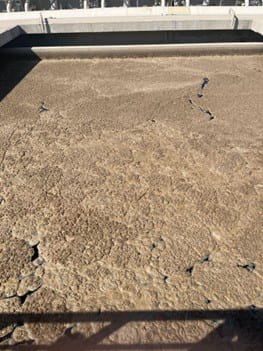
The flocculation basin separate suspended solids from the water. Here is an image of the suspended solids floating on top. Remaining impurities are removed through dual media gravity filtration.
In reverse osmosis, high pressure is applied to the salty water and then passed through a semipermeable membrane that only allows water ions to pass through. Because of the mineral deficiency of desalinated water, water is then passed through post-treatment, where minerals such as magnesium and calcium are added to meet consumption needs. Water is then transported in the water carrier pipelines for domestic usage.
One of the challenges desalination plants, including Sorek, face is the high energy required to operate the plant. Desalination takes about 3.4% of energy consumption in Israel. There are plans to increase the number of alternative energy sources such as solar and improve power-saving desalination techniques.
Post-treatment involves re-adding minerals like carbon to the water, cleaned out during the distillation process.
The water from the Mediterranean Sea is now ready to drink!
Reflection:
It is fascinating how Sorek can transform salt water into drinkable water. This is a process we were not familiar with in the United States. It is also a process that seems to amuse many Israelis. When talking to our taxi driver about the GET program, the driver did not know his drinking water came from the sea. The one problematic thing is if distillation is purifying the water too much. Our guide mentioned that not enough magnesium is added to the water, which can lead to health problems. Although water is not a primary source of magnesium, if agriculture is watered with desalinated water, the food might also lack magnesium. We wonder if there will be any problems in the future with drinking desalinated water.
The Global Engineering Trek (GET) to Israel is jointly organized by the Northwestern Center for Water Research (NCWR) and the Israel Innovation Project (IIP). This program is focused on the topic of water (GET Water-Israel) and is offered to all first- and second-year Northwestern undergraduate students. GET Water-Israel is co-sponsored by McCormick Global Initiatives, the Institute for Sustainability and Energy at Northwestern (ISEN), the Crown Family Center for Jewish and Israel Studies, NCWR, and IIP.


